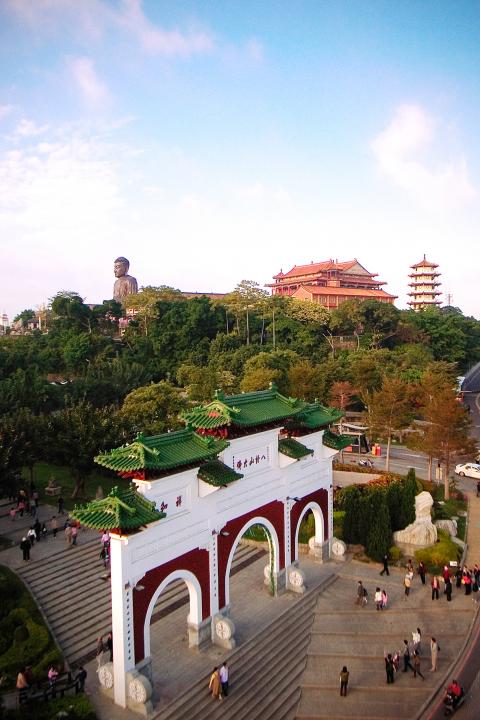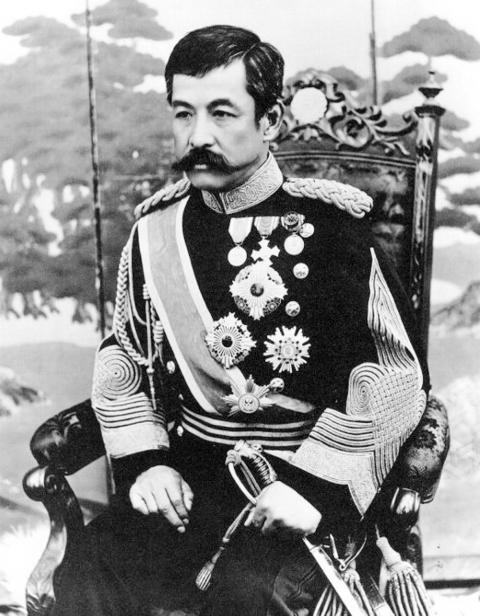Aug. 29 to Sept. 4
After landing in Taiwan and encountering much local resistance, the Japanese army reached the northern banks of the Dadu River (大肚溪), on what is today’s border between Taichung and Changhua County, on Aug. 25, 1895. They did not cross the river immediately, as the enemy had regrouped on the south banks in the city of Changhua and on the nearby battery on Baguashan (八卦山).
After a few days of scouting and minor skirmishes, the Japanese army of about 15,000 men split into two wings, with the left wing crossing the river in the dark on Aug. 27. They attacked the battery in the morning, and thus began the Battle of Baguashan (八卦山之役), the largest clash between the two sides.

Photo courtesy of Wikimedia Commons
On May 25, 1895, about a month after the Qing Empire ceded Taiwan to Japan, Qing officials and the Taiwanese elite established the Republic of Formosa (台灣民主國) in a bid to resist the transfer of Taiwan to Japan.
In the June 19 edition of Taiwan in Time, we examined the legacy of the resistance leaders who ran away upon defeat: republic president Tang Ching-sung (唐景崧), who fled to China after Keelung was captured, and vice president Chiu Feng-chia (丘逢甲), who did the same after the fall of Taipei. And finally Liu Yong-fu (劉永福), who jumped ship two days before the Japanese entered his stronghold of Tainan.
This week, we will remember those who stayed and fought to the death. After Chiu’s departure, Liu assumed leadership of the resistance. But his Black Flag Army remained stationed in Tainan, and someone needed to step up and stop the Japanese from moving south from Taipei.

Photo courtesy of Wikimedia Commons
HAKKA MILITIAS
Wu Tang-hsing (吳湯興), a Hakka from Miaoli, took on the task as he organized a militia comprised of fellow Hakka from the area and swore to defend their homeland to the death. Wu was later joined by Chiang Shao-tzu (姜紹祖) and Hsu Hsiang (徐驤), also Hakka who had recruited their own armies.
All three were scholars who had passed the imperial examinations, and it is said that Chiang was no more than 20 years old. The trio earned many monikers, and Chen Wen-teh (陳文德) refers to them in his book, Showdown at Bagua Mountain (決戰八卦山) as the “Three Hakka Musketeers (客家三劍客).”
Chen writes that this was not a formal army, and “the leaders’ command was not absolute,” as the units “often acted individually during battle, rarely being able to focus all their efforts on resisting the Japanese … Even though they did cause the Japanese a lot of trouble, their actual accomplishments were limited.”
This army first clashed with the Japanese in northern Hsinchu. Wu personally led the resistance, driving away the enemy twice. But soon, the Japanese regrouped and decided to charge at full force, capturing Hsinchu a week later despite the Hakka army’s guerrilla tactics.
Chiang was captured in an attempt to retake Hsinchu, and he reportedly committed suicide by ingesting opium. As the Hakka militia retreated to Miaoli, they were joined by Wu Peng-nian (吳彭年) of the Black Flag Army. Wu Peng-nian was not a native of Taiwan, having arrived as Liu’s top aide, but Chen writes that he had decided to defend Taiwan at all cost.
THE DECISIVE BATTLE
After much fierce fighting, the Japanese captured Taichung, and the resistance regrouped in Changhua with between 3,000 and 5,000 troops, comprised of surviving members of the Hakka militia, Black Flag Army and remaining Qing troops.
The Japanese army’s right wing remained on the north bank, lighting camp fires and firing cannons to divert the resistance’s attention while the left wing had arrived unnoticed at the foot of Baguashan, which was guarded by Wu Tang-hsing’s unit and soon joined by Hsu’s.
The resistance fired their cannons at the advancing enemy to no avail, and an intense battle ensued between the two sides. Meanwhile, the Japanese right wing had crossed the river and engaged with the Black Flag Army.
Unable to withstand the Japanese army’s superior artillery, Wu Tang-hsing was killed here while Hsu managed to break out of the siege. Upon seeing the Japanese flag raised on Baguashan, Wu Peng-nian rushed to reclaim the battery and also died in the effort. The Japanese took Changhua easily after that, and continued their push south.
Hsu continued to fight after this campaign, and died near Douliou (斗六) in Yunlin County, the last of the musketeers to fall.
Taiwan in Time, a column about Taiwan’s history that is published every Sunday, spotlights important or interesting events around the nation that have anniversaries this week.

This month the government ordered a one-year block of Xiaohongshu (小紅書) or Rednote, a Chinese social media platform with more than 3 million users in Taiwan. The government pointed to widespread fraud activity on the platform, along with cybersecurity failures. Officials said that they had reached out to the company and asked it to change. However, they received no response. The pro-China parties, the Chinese Nationalist Party (KMT) and Taiwan People’s Party (TPP), immediately swung into action, denouncing the ban as an attack on free speech. This “free speech” claim was then echoed by the People’s Republic of China (PRC),

Exceptions to the rule are sometimes revealing. For a brief few years, there was an emerging ideological split between the Democratic Progressive Party (DPP) and Chinese Nationalist Party (KMT) that appeared to be pushing the DPP in a direction that would be considered more liberal, and the KMT more conservative. In the previous column, “The KMT-DPP’s bureaucrat-led developmental state” (Dec. 11, page 12), we examined how Taiwan’s democratic system developed, and how both the two main parties largely accepted a similar consensus on how Taiwan should be run domestically and did not split along the left-right lines more familiar in

Many people in Taiwan first learned about universal basic income (UBI) — the idea that the government should provide regular, no-strings-attached payments to each citizen — in 2019. While seeking the Democratic nomination for the 2020 US presidential election, Andrew Yang, a politician of Taiwanese descent, said that, if elected, he’d institute a UBI of US$1,000 per month to “get the economic boot off of people’s throats, allowing them to lift their heads up, breathe, and get excited for the future.” His campaign petered out, but the concept of UBI hasn’t gone away. Throughout the industrialized world, there are fears that

Most heroes are remembered for the battles they fought. Taiwan’s Black Bat Squadron is remembered for flying into Chinese airspace 838 times between 1953 and 1967, and for the 148 men whose sacrifice bought the intelligence that kept Taiwan secure. Two-thirds of the squadron died carrying out missions most people wouldn’t learn about for another 40 years. The squadron lost 15 aircraft and 148 crew members over those 14 years, making it the deadliest unit in Taiwan’s military history by casualty rate. They flew at night, often at low altitudes, straight into some of the most heavily defended airspace in Asia.